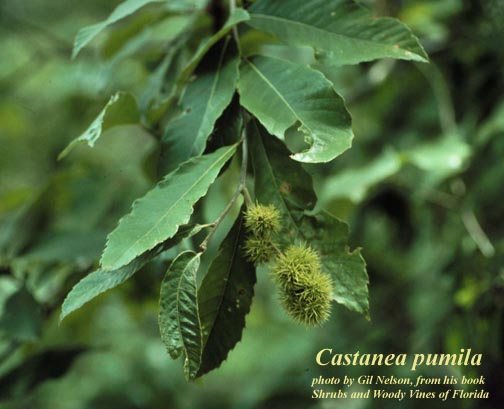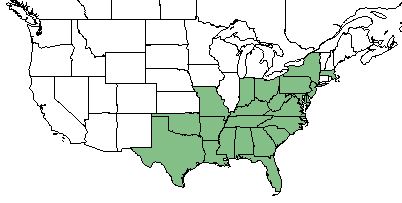Castanea pumila
Common name: chinquapin [1], common chinquapin[2]
| Castanea pumila | |
|---|---|

| |
| Photo by the Atlas of Florida Plants Database | |
| Scientific classification | |
| Kingdom: | Plantae |
| Division: | Magnoliophyta - Flowering plants |
| Class: | Magnoliopsida - Dicots |
| Order: | Fagales |
| Family: | Fagaceae |
| Genus: | Castanea |
| Species: | C. pumila |
| Binomial name | |
| Castanea pumila (L) Mill. | |

| |
| Natural range of Castanea pumila from USDA NRCS Plants Database. | |
Contents
Taxonomic Notes
Synonyms: Castanea pumila var. pumila[2]
Varieties: Castanea alnifolia Nuttall; C. alnifolia Nuttall var. alnifolia; C. alnifolia Nuttall var. floridana Sargent; Castanea ashei (Sudworth) Sudworth; Castanea floridana (Sargent) Ashe; Castanea pumila (Linnaeus) P. Miller; C. pumila var. ashei Sudworth; C. pumila (Linnaeus) P. Miller var. margarettae W.W. Ashe; C. pumila var. pumila[2]
Description
C. pumila is a perennial shrub tree of the Fagaceae family native to North America[1] and grows as a single or multi-trunked tree with horizontal lower branches which are ascending in the upper crown.[3] The twigs are covered in dense, wooly hairs when young, and become shiny brown with densely hairy reddish buds as they age. The leaves are alternate, simple, prominently veined, short-stemmed, wooly on underside, and oblong shape with fine pointed teeth. Male flowers are located in leaf axils, clustered, elongated, yellow or white in color, and have a strong odor. Female flowers more round in comparison. The fruit houses a single nut in a spiny bur.[4]
Distribution
C. pumila can be found along the southeastern coast of the United States, from Texas to Massachusetts.[1] It has been planted in the states of Wisconsin and Michigan, and its native range is from New Jersey to Florida as well as over to Texas and Oklahoma. However, it is rare in its natural range.[4]
Ecology
Habitat
It can be found in xeric forests and woodlands, including mixed hardwood forests along with longleaf pine and scrub oak trees on slopes and high ridges free from limestone.[5][4] It is also found along sand ridges. [6] C. pumila can also be found on dry pinelands, well-drained stream terraces, various disturbed areas, old fields, and pine plantations; soils it can be found on include xeric and mesic sites on rocky, dry, loamy, or sandy soils.[7][4] It is a known characteristic species of shortleaf pine-oak-hickory woodlands.[8]
Associated species include Pinus echinata, Pinus palustris, Quercus stellata, Quercus hemisphaerica, Carya tomentosa, Carya sp., Verbesina aristata, Nyssa sylvatica, Nyssa sp., Prunus alabamensis, Asimina parviflora, Magnolia grandiflora, and Vaccinium arboreum.[7]
Phenology
C. pumila has been observed to flower between March and June. [9]
Seed bank and germination
For propagation purposes, seeds must be sown in the fall or stratified for germination with the husks removed. For best results, the seeds should be stratified between 30 and 60 days at 41 degrees.[3]
Fire ecology
C. pumila is found mostly in fire-maintained habitats.[5][7] It is not fire resistant, but has a high fire tolerance.[1] It forms extensive clones in areas where it is burned annually; the species earnestly resprouts when top-killed by fire.[4]
Pollination
The genus Castanea is self-sterile, even though the pistillate and staminate flowers are usually borne in separate clusters on the same tree. It is wind pollinated.[10] This species has been observed to host pollinators from the Andrenidae family such as Andrena rehni and Andrena w-scripta, as well as aphids such as Calaphis betulaecolens (family Aphididae), plant bugs such as Reuteroscopus ornatus (family Miridae), and leafhoppers from the family Cicadellidae such as Graphocephala fennahi, Scaphytopius sp., Typhlocyba sp., and Eratoneura parva.[11]
Herbivory and toxicology
C. pumila is highly palatable to browsing animals and is edible by humans, but is not very palatable to grazing animals.[1] The nuts are eaten by squirrels, bobwhite quail, grouse, wild turkey, chipmunks, opossums, blue jays, woodpeckers, and other various birds. White-tailed deer also browse the foliage.[4][12] It is also a larval host for the orange-tipped oakworm moth (Anisota senatoria).[3]
Diseases and parasites
C. pumila is relatively resistant to chestnut blight. [5]
Conservation, cultivation, and restoration
It is listed as threatened by the Kentucky State Nature Preserves Commission, and listed as endangered by the New Jersey Department of Environmental Protection and Energy.[1] C. pumila has also mostly been extirpated by chestnut blight in Alabama.[4] For management, weeds should be controlled around the new established plants for a minimum of two years, and if growth is not satisfactory, then a handful of fertilizer should be worked into the soil around the sapling.[12] The known cultivar of C. pumila is 'Golden' in Georgia, released in cooperation by the USDA-NRCS Plant Materials Center in Quicksand, Kentucky, the Kentucky Agricultural Experiment Station, and the Kentucky Department of Fish & Wildlife.[12] This cultivar is used for its qualities of adaptability to harsh sites as well as its wildlife value.[4]
Cultural use
The nuts were a favorite of Native Americans.[3] Historically, the Cherokee Native American tribe used the dried leaves as washes to alleviate fevers, chills, headaches, fever blisters, and cold sweats. As well, the Koasati tribe utilized the roots to treat stomachaches. Today, chinkapin nuts as well as the wood are sold commercially.[4] Medicinally, C. pumila is an astringent, a febrifuge (driving away fever), and a tonic (permanently strengthening).[13]
The Castanea species were important food sources in early America, Europe, and Asia. It could be used to make bread that was a substitute for potatoes and wheat in southern Europe, or could be cooked as a vegetable or added to stews or even ground into flour. The boiled nuts could be mashed and eaten like potatoes or made into fritters. The nuts can also produce a sugar that can be extracted for use, or they can be roasted and used like coffee, and in some cases they can make a chocolate comparable to that made from cacao.[14]
Photo Gallery
References and notes
- ↑ 1.0 1.1 1.2 1.3 1.4 1.5 USDA Plant Database https://plants.usda.gov/core/profile?symbol=CAPU9
- ↑ 2.0 2.1 2.2 Weakley, A.S. 2020. Flora of the Southeastern United States. Edition of 20 October 2020. University of North Carolina at Chapel Hill, Chapel Hill, North Carolina.
- ↑ 3.0 3.1 3.2 3.3 [[1]] Lady Bird Johnson Wildflower Center. Accessed: April 2, 2019
- ↑ 4.0 4.1 4.2 4.3 4.4 4.5 4.6 4.7 4.8 Wennerberg, S. (2006). Plant Guide: Chinkapin Castanea pumila. N.R.C.S. United States Department of Agriculture. Baton Rouge, LA.
- ↑ 5.0 5.1 5.2 Weakley, A. S. (2015). Flora of the Southern and Mid-Atlantic States. Chapel Hill, NC, University of North Carolina Herbarium.
- ↑ Johnson, A. S. and J. L. Landers (1978). "Fruit production in slash pine plantations in Georgia." The Journal of Wildlife Management 42(3): 606-613.
- ↑ 7.0 7.1 7.2 URL: http://herbarium.bio.fsu.edu. Last accessed: June 2018. Collectors: Loran C. Anderson, Robert K. Godfrey, Wayne R. Faircloth, A. F. Clewell, C. Jackson, H. Kurz, W. D. Reese, Wilson Baker, R. Kral, Robert W Simons, Richard S. Mitchell, Erdman West, Angus Gholson, George P. Johnson, Lucy B. Abbe, Ernst C. Abbe, Robert F. Martin, R. F. Thorne, R. A. Davidson, D.B. Ward, R.B. Smith, John K. Small, Ed Keppner, Lisa Keppner, Rodie White, R. Komarek, Andre F. Clewell, D. Demaree, Kathleen Craddock Burks, Travis MacClendon. States and counties: Leon County Florida, Calhoun County Florida, Santa Rosa County Florida, Wakulla County Florida, Suwannee County Florida, Hamilton County Florida, Walton County Florida, Okaloosa County Florida, Columbia County Florida, Jackson County Florida, Alachua County Florida, Duval County Florida, Escambia County Florida, Madison County Florida, Gilchrist County Florida, Bay County Florida, Liberty County Florida, Washington County Florida, Gadsden County Florida, Grady County Georgia, Thomas County Georgia, Decatur County Georgia, Carroll County Arkansas, Franklin County Florida, Autauga County Alabama.
- ↑ Clewell, A. F. (2013). "Prior prevalence of shortleaf pine-oak-hickory woodlands in the Tallahassee red hills." Castanea 78(4): 266-276.
- ↑ Nelson, G. PanFlora: Plant data for the eastern United States with emphasis on the Southeastern Coastal Plains, Florida, and the Florida Panhandle. www.gilnelson.com/PanFlora/ Accessed: 18 MAY 2018
- ↑ [[2]] Natureserve Explorer. Accessed: April 2, 2019
- ↑ Discoverlife.org [3]
- ↑ 12.0 12.1 12.2 USDA NRCS Plant Materials Program. (2006). Plant Fact Sheet: Allegheny Chinkapin Castanea pumila. N.R.C.S. United States Department of Agriculture.
- ↑ Nickell, J. M. (1911). J.M.Nickell's botanical ready reference : especially designed for druggists and physicians : containing all of the botanical drugs known up to the present time, giving their medical properties, and all of their botanical, common, pharmacopoeal and German common (in German) names. Chicago, IL, Murray & Nickell MFG. Co.
- ↑ Fernald, et al. 1958. Edible Plants of Eastern North America. Harper and Row Publishers, New York.